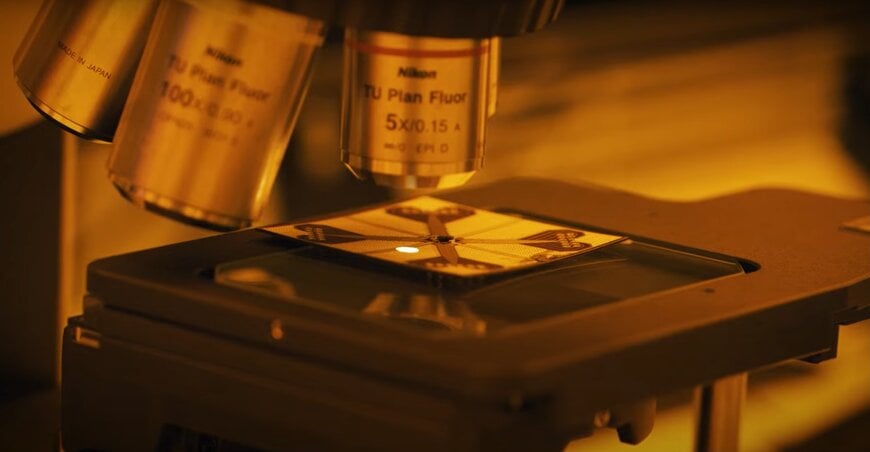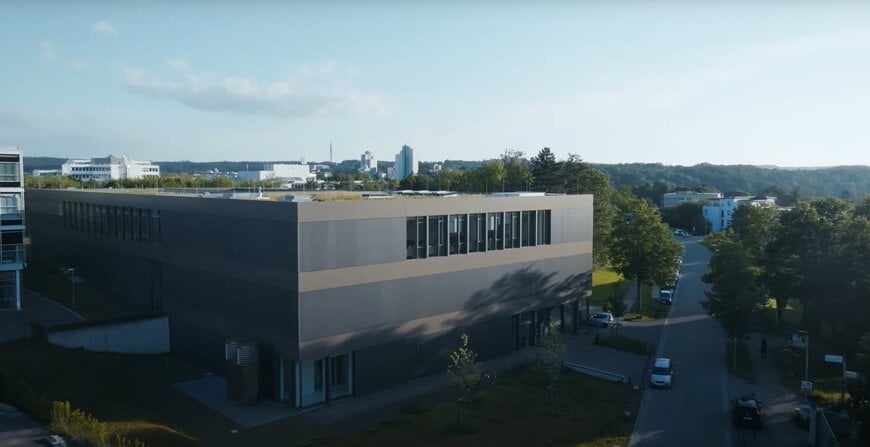University of Stuttgart and Nano Dimension Advance Quantum Sensing with 3D Printed Electronics
QSens initiative leverages Nano Dimension’s DragonFly IV to develop scalable, high-performance quantum sensors for medical, neural, and industrial use.
www.nano-di.com

Thanks to their unparalleled sensitivity, quantum sensors are poised to revolutionize various fields, from medical technology to autonomous navigation and renewable energies. These sensors are at the forefront of quantum technology, offering measurement capabilities that approach the theoretical limits of sensitivity. However, the development and deployment of quantum sensors often requires sophisticated equipment and resources that many universities and research labs lack. The BMBF Cluster4Future QSens initiative is pioneering the transformation of this field, aiming to bridge the gap between academic research and industrial application. By leveraging additively manufactured electronics (AME), they are developing scalable, affordable quantum sensors for a wide range of fields, democratizing access to advanced quantum research and fostering innovation in quantum sensor technology.
The Challenge: Advancing Quantum Sensor Development
Capable of detecting even the faintest of signals – such as magnetic fields, temperature changes, and brain activity – with extreme precision, quantum sensors offer the promise of transforming a diverse range of industries. However, developing quantum sensors requires access to specialized, high-cost resources, typically only available in large research institutions and laboratories. Even then, production is hampered by slow, complex processes with limited scalability, ultimately hindering innovation and pace of research.
QSens “Quantum Sensors of the Future” – a consortium comprising 15 industrial partners, the Universities of Stuttgart, Ulm and Tuebingen, the Charité in Berlin, and three research institutions – has set itself the task to overcome these barriers and pioneer the advancement of quantum research at an unprecedented pace. With the ambitious mission to bring quantum sensors to the market over the next five to nine years, the group sought a solution that would address these key challenges and allow for the scalable integration of electronics, photonics, and quantum sensor technology, while reducing the time and cost investment that typically restricts accessibility.
The Solution: AME with DragonFly IV
To meet these demands, the team at the University of Stuttgart integrated Nano Dimension’s DragonFly IV 3D printing system, a cutting-edge platform for AME, into its research workflow and manufacturing platform Quantum4SME. The technology offers a unique solution by combining additive manufacturing with the ability to print both conductive and non-conductive materials in a single process. This unlocks the creation of complex, multi-layered electronic circuits and, critically, the heterogeneous integration of quantum devices. These include electronic circuits, sensors, photonic elements or other components in compact devices with high packaging density. This is critical in creating specialized quantum devices for a range of applications, from measuring brain activity or nerve signals in the medical field, to evaluating atomic structure in chemical engineering.
Traditional manufacturing of electronic components – particularly complex devices such as advanced quantum sensors – often involves lengthy and costly processes, including multiple stages of design, prototyping, and testing. Leveraging AME drastically streamlines this process, allowing for rapid prototyping and immediate testing of new designs. Crucially, this efficiency reduces the time and financial barriers associated with developing and refining quantum sensors. By doing so, institutions are not only able to access these advanced technologies, but to compete with larger, better-funded counterparts – ultimately driving the industry forward and boosting the pace of innovation.
Paving the Way for Quantum Breakthroughs
Since its installation in a dedicated research building within the Center for Applied Quantum Technology (ZAQuant) at the University of Stuttgart, experts in quantum physics, photonics and engineering science have been able to collectively leverage the capabilities of the Dragonfly IV for applied quantum research – with transformative effect. Within months of installation, the 3D printer has created a step-change in the pace of research and opened up entirely new interest areas in a number of fields.
“We use a lot of microelectronics and photonic integration technologies that rely on hybrid integration solutions, such as additive manufacturing, to bring these technologies together,” explains Professor Dr. Jens Anders, QSens. “The Dragonfly IV is designed for multi-material, multi-layer 3D printing, so it can create entire circuits in one step, including conductive structures and non-conductive structures, to heterogeneously co-integrate electronic devices and our quantum sensors. This is key in producing devices that are scalable – ultimately a critical part of bringing quantum technology farther and wider, so that its many benefits can be accessed by more institutions in a greater number of industry sectors.”
As Anders’ colleague, Felix Schuderer, of the Institute of Smart Sensors states, “our aim is to bring quantum sensors to everyone in the world, not for it to be restricted to big laboratories with very heavy instrumentation.” The Dragonfly IV provides a crucial next step in advancing this journey.
Transforming the Medical Landscape with Quantum-Enhanced Precision
Whilst QSens’ research spans a vast array of application areas, the potential for medical devices is arguably one of the most significant – with the Dragonfly IV also already proving transformative in areas such as Magnetic Resonance Imaging (MRI). By nature, the MRI process requires highly sensitive and precisely manufactured coils to detect the faint magnetic fields generated by atomic nuclei. Whereas traditional coil manufacturing processes can be cumbersome, expensive, and limited in design flexibility, AME offers a revolutionized approach, enabling the rapid production of custom-designed coils with optimized geometries and material properties. This flexibility not only enhances the performance of MRI systems but also reduces development time and costs, making advanced MRI technology more accessible to research institutions.
Similarly, neural sensors are another application area where AME is already changing the game for researchers at the university – and undoubtedly for the wider market in the future. Where wider market access has traditionally been restricted by the large device size and cost, heterogeneous integration with AME presents a very promising avenue to improve sensor size, scalability, and costs. This is paving the way towards the implementation of quantum sensors in entirely new avenues, with researchers at QSens already exploring possibilities around neural-controlled prosthetics and other dynamic and rapidly-evolving application areas.
“My work is related to flexible sensors, including pressure sensors and strain sensors, which are central to research with robotics on prosthetic limbs,” explains Jasmin Atta, part of the Academic team at the Institute of Smart Sensors, University of Stuttgart. “Historically, flexible sensors have been extremely difficult to produce. Now, with the help of these 3D printers, we are able to achieve any kind of pattern, any kind of design.” This level of flexibility is proving pivotal in the team’s research efforts, with the capabilities of the Dragonfly IV also providing a host of process efficiencies and performance benefits that are helping to drive a seamless transition to the adoption of AME.

Implications for Tomorrow’s Research Landscape
The embrace of AME by institutions like the University of Stuttgart and QSens underscores a broader trend toward democratizing access to cutting-edge research tools. For universities and research labs, the ability to produce sophisticated electronic components in-house represents a significant shift. This accessibility empowers researchers to innovate rapidly, iterate designs, and conduct experiments without the constraints imposed by traditional manufacturing methods.
The versatility of AME also allows researchers to experiment with novel designs and materials, tailored to specific research needs, that would be difficult or impossible to achieve with conventional methods. For quantum sensor development, this means the ability to design sensors with unique properties that enhance sensitivity, accuracy, and functionality, ultimately moving the needle in a number of important research areas, which then translate into meaningful, real-world differences.
“As part of the QSens initiative, we also collaborate with the University Hospital in Tübingen, where the additively manufactured quantum devices that our team has developed here, in-house, will actually be used live on patients,” explains Professor Anders.
By integrating AME into quantum sensor research, the University of Stuttgart and QSens have set the stage for a paradigm shift in sensor development. The adoption of additive manufacturing has not only made advanced quantum sensors more accessible but has also empowered smaller research institutions to compete on the global stage. The success of this collaboration positions Germany as a leader in quantum sensor technology and fosters a regional ecosystem for the development and industrial production of quantum devices. As Anders concludes, working at the very forefront of innovation with industry-leading AM technology has given the University of Stuttgart and QSens an important edge.
“Because scalable quantum sensors require the most cutting-edge, novel technologies and devices, the current market is still developing and fairly small. However, this also means that, at the moment, our work and our technologies are garnering interest from literally all of the companies in our network, he says.
As AME continues to evolve, the technology will undoubtedly play an increasingly crucial role in democratizing quantum research, enabling researchers to innovate faster, reduce costs, and bring advanced quantum sensor technology to market more efficiently, with a promising real-world impact.
www.nano-di.com

